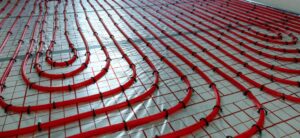One of the biggest benefits of radiant heat flooring is its versatility when heating a whole home – whether new build or remodel. Like any home improvement, there are certain applications where it works better than others, and that’s no more paramount than in the type of floor you choose to go over the heating system. Certain materials are better than others, and choosing the right option will ensure that you get the most out of your radiant heat investment.
Porcelain or Ceramic Tile
Since both of these tile options are mineral-based, they make for excellent heat conductors. As an additional plus, the synthetic nature of the material means that they likely won’t rot or degrade if the hydronic system ever leaks (which is highly unlikely).
Either tile is suitable for any room, including laundry, corridors, foyers, bathrooms, kitchens, and more. As a general rule, the thicker the tile, the longer it will take to heat up, but the longer it will also hold on to heat.
Laminate Flooring
Most laminate is thin, meaning that heat will move directly through it and into your home. However, laminate has a temperature max of 81-85 degrees Fahrenheit, so extremely hot environments may not be the best fit. However, the composite of laminate with foam underlay makes for a very comfortable foot feeling in the coldest rooms.
Engineered Wood Flooring
Engineers wood uses high-caliber plywood as the base below a much nicer-looking hardwood veneer top layer. The plywood is purposeful in that it responds to temperature changes much better and can make up for wood’s poor heat conduction ability. Bamboo or softwood are other popular and durable options. Solid hardwood tends to be less effective due to changes based on temperature fluctuation.
Sheer or Tile Vinyl Flooring
These types of vinyl, luxury vinyl planks, or otherwise, are also suitable options. They typically have particular installation instructions and have temperature minimums and maximums for efficient and safe use.
Carpeting
There are mixed opinions on using carpeting, as it’s typically a warm layer on its own. It could be a good option for those looking for even more warmth and who don’t mind turning up the thermostat to compensate for any heat loss through the piling. It’s also important to consider the carpet’s thickness, in addition to the thermal resistance of the underlay (most manufacturers can provide the heating tog-value or R-value for their specific products).
Radiant heat flooring is a house-warming option fast-growing in popularity. The professionals at Radiant Heat Flooring can explain and detail the various options open to you as a homeowner and help you decide which option is best for decades of efficiency and low-stress use. Call (503) 788-7777 to learn more.



